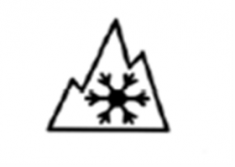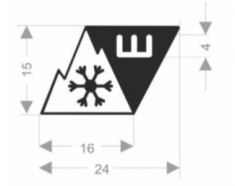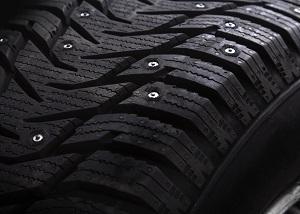Good winter tyres are indispensable for driving safely on snowy or icy roads, and many countries impose specific winter tyre requirements. These vary from country to country, but usually define winter tyres as those identified with special markings. The entry-level winter tyres are marked M+S (Mud plus Snow). Advanced winter tyres for use in severe snow conditions are marked with an alpine symbol or Three Peak Mountain SnowFlake (3PMSF):

These tyres must pass a special snow grip test and be type approved according to UN Regulation No. 117.
There exists another large group of winter tyres: the ones equipped with studs of hard material (e.g. metal) to improve traction properties on ice surfaces and packed snow. However, studded tyres fall out of the scope of UN Regulation No. 117, and therefore are not allowed to be marked with the snow grip symbol, in spite of their good performance. This situation has created problems in some countries regarding the acceptance of studded tyres as winter tyres.
To fill this gap, this week the World Forum for Harmonization of Vehicle Regulations (WP.29) adopted today a new UN Regulation to cover performance requirements and marking of studded tyres. The draft was prepared by a group of experts from Governments and the tyre industry, under the leadership of Finland. The new Regulation is expected to enter into force in September 2022.
The new Regulation will increase road safety by introducing harmonized snow grip requirements for studded tyres. It will equally simplify the legislative situation in countries that allow the usage of studded tyres on public roads, such as Finland, Sweden, Norway, Estonia, Russian Federation, and in several other European countries which either fully or through specifically defined regions or use cases allow the use of studded tyres in their territories. Finally, consumers will benefit from more coherent winter tyre markings.
The new Regulation covers studded tyres for passenger cars, buses and trucks and introduces strict requirements and procedures for testing their snow grip . Only studded tyres which meet the minimum performance criteria may be marked with a special symbol. This marking consists of two parts: the alpine symbol 3PMSF of UN Regulation No. 117 and an additional part depicting the Cyrillic letter "Sha" Ш , the first letter in the Russian word for “studs” (see the picture below). The word "STUDDED" will also be added into the tyre sidewall.

At this stage, the new Regulation includes only snow grip performance and markings. As a next step, ice grip procedures and markings will be elaborated for studded tyres of passenger cars.
Note to editors
About the World Forum for Harmonization of Vehicle Regulations
The World Forum for Harmonization of Vehicle Regulations (WP.29) is a Working Party within UNECE. It manages three Global Agreements on vehicles: 1958 Agreement (UN Regulations); 1998 Agreement (UN Global Technical Regulations); and 1997 Agreement (UN Rules on Periodic Technical Inspections). Any country that is member of the United Nations may participate in the activities of the World Forum and accede to the Agreements.
About the 1958 Agreement
The 1958 Agreement establishes an international legal framework of technical Regulations and recommendations for wheeled vehicles, their parts and equipment.
The 1958 Agreement enables internationally harmonized specifications for the construction and certification of new vehicles, helping to reduce costs and facilitate access to international markets. As a result, consumers benefit from a wider choice of efficient, safe and environmentally friendly vehicles.


